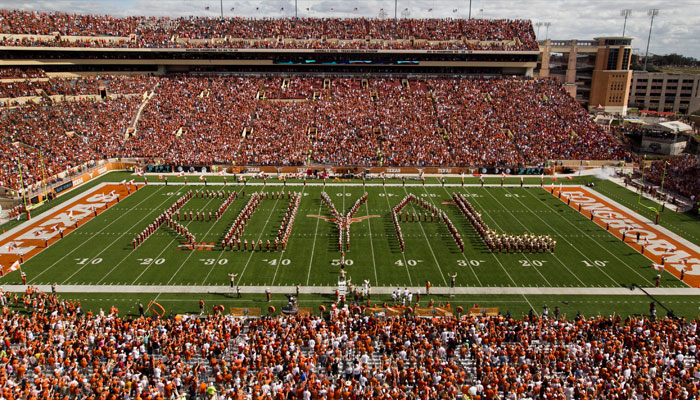Texas Memorial Stadium

Texas Memorial Stadium is a football stadium located on the campus of the University of Texas at Austin. The stadium was first opened in 1924 and has since undergone several renovations and expansions. It serves as the home field for the Texas Longhorns football team and is known for its size and iconic design.
Dimensions:
Texas Memorial Stadium has a seating capacity of approximately 100,119, making it one of the largest stadiums in the United States. The stadium measures 360 feet long and 160 feet wide, with a playing surface of natural grass.
Facilities:
The stadium features several amenities for visitors, including luxury suites, a club lounge, a state-of-the-art video board, and multiple concessions stands. It also has several retail stores and merchandise stands, as well as a large parking lot.
Track surface:
Texas Memorial Stadium does not have a track surface, as it is primarily used for football games.
Field events:
Similarly, the stadium does not typically host field events, as it does not have a dedicated field space. However, in the past it has been used for marching band competitions and other cultural events.
Events and competitions:
Texas Memorial Stadium primarily hosts football games for the Texas Longhorns, as well as other sporting events such as soccer matches and track and field meets. The stadium has also been used for concerts, political rallies, and other community events.
Safety:
Texas Memorial Stadium has implemented several safety measures to ensure the safety of visitors to the stadium. These include enhanced screening procedures for visitors, such as bag checks and metal detectors, as well as increased security personnel on site. Additionally, the stadium has implemented measures to prevent accidents or injuries, such as anti-slip flooring and safety rails.
Sustainability:
Texas Memorial Stadium has made efforts to reduce its environmental impact and promote sustainability. The stadium has implemented several initiatives to reduce its carbon footprint and waste, including using energy-efficient lighting, reducing water consumption, and recycling materials. The stadium has also implemented a composting program to reduce the amount of organic waste generated at events.




